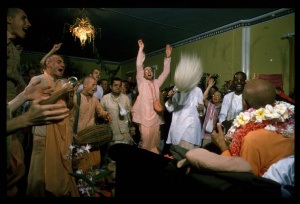CC Madhya 20.184 (1975)

A.C. Bhaktivedanta Swami Prabhupada
Below is the 1996 edition text, ready to be substituted with the 1975 one using the compile form.
TEXT 184
- tad-ekātma-rūpe ‘vilāsa’, ‘svāṁśa’—dui bheda
- vilāsa, svāṁśera bhede vividha vibheda
SYNONYMS
tat-ekātma-rūpe—in the form of tad-ekātma; vilāsa—pastime; svāṁśa—personal expansion; dui bheda—two divisions; vilāsa—of the pastime expansion; svāṁśera—of the personal expansion; bhede—by differences; vividha—various; vibheda—distinctions.
TRANSLATION
“In the tad-ekātma-rūpa there are pastime expansions [vilāsa] and personal expansions [svāṁśa]. Consequently there are two divisions. According to pastime and personal expansion, there are various differences.
PURPORT
The Lord’s vilāsa expansions are described in the following verse from the Laghu-bhāgavatāmṛta (1.15):
- svarūpam anyākāraṁ yat tasya bhāti vilāsataḥ
- prāyeṇātma-samaṁ śaktyā sa vilāso nigadyate
“When the Lord displays numerous forms with different features by His inconceivable potency, such forms are called vilāsa-vigrahas.” The Lord’s svāṁśa expansions are also described in the Laghu-bhāgavatāmṛta (1.17):
- tādṛśo nyūna-śaktiṁ yo vyanakti svāṁśa īritaḥ
- saṅkarṣaṇādir matsyādir yathā tat-tat-svadhāmasu
When a form of Kṛṣṇa is nondifferent from the original form but is less important and exhibits less potency, it is called svāṁśa. Examples of svāṁśa expansions can be found in the quadruple forms of the Lord residing in Their respective places, beginning with Saṅkarṣaṇa, Vāsudeva, Pradyumna and Aniruddha, and also in the puruṣa-avatāras, līlā-avatāras, manvantara-avatāras and yuga-avatāras.